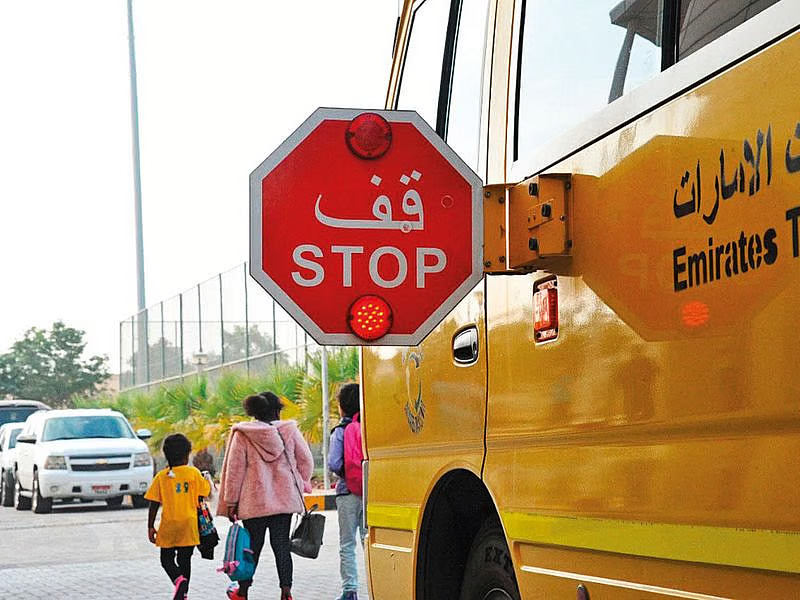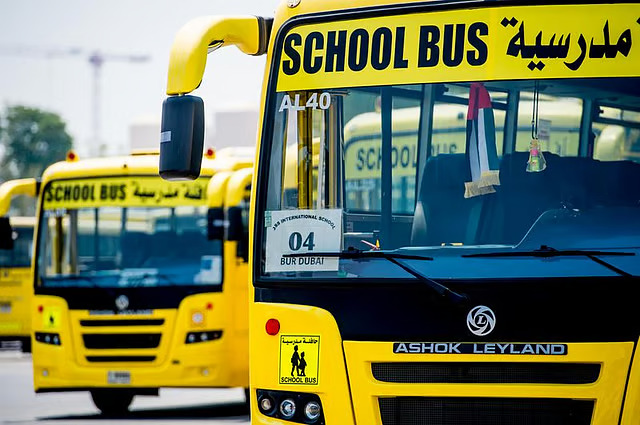Stop arms, GPS tracking and CCTVs – these are some of the feature that keep students safe
Dubai: For parents across the UAE, ensuring the safety of their children during daily school journeys remains a top priority. To provide peace of mind, the UAE has implemented comprehensive regulations and equipped school buses with advanced safety features designed specifically to protect young passengers.
From automatic stop arms that alert nearby drivers to strict traffic rules, to GPS tracking, CCTV surveillance, and emergency preparedness, every aspect of school bus safety is carefully managed.
These combined measures create a secure environment for students during pick-up and drop-off times, reinforcing the country’s commitment to child safety on the road.
Automatic stop arms
One of the most visible and crucial safety features on UAE school buses is the automatic stop arm.
The automatic stop arm is installed on the external side of school buses, just behind the driver’s door. This stop arm extends automatically whenever the bus stops to pick up or drop off students and displays flashing red lights. This signals all nearby vehicles to stop and maintain a safe distance.
School bus drivers face a Dh500 fine and six black points if they fail to activate the stop arm when stopping. Meanwhile, motorists caught ignoring the stop arm face a Dh1,000 fine plus 10 black points.

Rules for motorists when a stop arm is displayed
- On single-lane roads: Vehicles travelling in both directions must stop and keep at least five metres away from the school bus.
- On multi-lane roads: Only vehicles travelling in the same direction as the bus must stop and maintain a five-metre distance.
Additional safety features on school buses
GPS tracking: School buses are equipped with Global Positioning Systems (GPS), enabling real-time tracking of their location. Companies like STS Group (School Transport Services Group) integrate GPS with fleet management systems, allowing schools and often parents to monitor bus movements. This provides transparency and allows for a quick response in case of unforeseen delays or incidents.
CCTV surveillance: CCTV cameras are widely installed on school buses across the UAE. These cameras serve multiple purposes:
- Monitoring stop arm compliance: In Abu Dhabi, cameras are specifically designed to catch motorists who illegally drive past a bus when its stop sign is extended. This footage serves as concrete evidence for enforcement.
- Onboard security: Cameras provide comprehensive internal monitoring, ensuring student discipline and safety, and are crucial for investigating any incidents inside the bus.
Emergency exits: Every school bus is mandated to have a sufficient number of emergency exits proportionate to its seating capacity, with at least one on each side. Passenger exit doors and the driver’s door are not considered emergency exits. These exits are clearly marked with visible signs and must remain unobstructed.
Speed limiters: School buses are fitted with speed control devices to ensure they do not exceed regulated speed limits, typically 80 km/h on highways and 40 km/h on internal roads.
Regular maintenance and inspections: Transport authorities such as the Roads and Transport Authority (RTA) in Dubai conduct regular inspections of school buses to ensure compliance with all safety and technical specifications. These include vehicle design, internal layout, and the functionality of safety features. School buses also have a maximum lifespan, typically 15 years from the date of manufacture.
Trained personnel: Drivers undergo rigorous training that includes safe driving techniques, emergency response, and fire safety. Bus attendants are also trained in first aid and managing children effectively.






